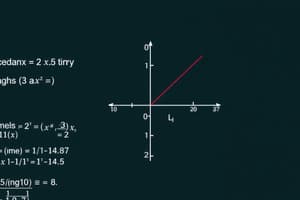Podcast
Questions and Answers
What is the definition of the Linear (Parent) Function?
What is the definition of the Linear (Parent) Function?
- f(x) = x (correct)
- f(x) = a|x-h| + k
- f(x) = |x|
- f(x) = -f(x)
What is the definition of the Absolute Value (Parent) Function?
What is the definition of the Absolute Value (Parent) Function?
- f(x) = |x| (correct)
- f(x) = a|x-h| + k
- f(x) = x
- f(x) = -f(x)
What is the Vertex Form of an Absolute Value Function?
What is the Vertex Form of an Absolute Value Function?
a | x-h | + k
What does 'a' represent in the Vertex Form?
What does 'a' represent in the Vertex Form?
What is the Vertex in Vertex Form?
What is the Vertex in Vertex Form?
What does f(x+h) represent?
What does f(x+h) represent?
What does f(x-h) represent?
What does f(x-h) represent?
What does f(x)+k represent?
What does f(x)+k represent?
What does f(x)-k represent?
What does f(x)-k represent?
What does it mean when a function is skinnier/vertical stretch?
What does it mean when a function is skinnier/vertical stretch?
What does it mean when a function is wider/horizontal stretch?
What does it mean when a function is wider/horizontal stretch?
What is the transformation for reflection/flip over the x-axis?
What is the transformation for reflection/flip over the x-axis?
Flashcards are hidden until you start studying
Study Notes
Parent Functions
-
Linear Function: Defined as f(x) = x or y = x. It represents a straight line with a constant slope.
-
Absolute Value Function: Represented as f(x) = |x| or y = |x|. Forms a V shape on the graph, reflecting all negative values above the x-axis.
Vertex Form of Absolute Value Function
- General Form: a |x - h| + k, where (h,k) indicates the vertex of the function.
Characteristics of Vertex Form
-
Slope: The slope of the right side of the vertex is a, while the left side slope is -a.
-
Vertex: Given by the coordinates (h, k), the vertex is the point at which the graph changes direction.
Transformations of Functions
-
Shift Left: The transformation f(x + h) shifts the graph to the left by 'h' units.
-
Shift Right: The transformation f(x - h) shifts the graph to the right by 'h' units.
-
Shift Up: The transformation f(x) + k shifts the graph upward by 'k' units.
-
Shift Down: The transformation f(x) - k shifts the graph downward by 'k' units.
Dilation
-
Vertical Stretch: Occurs when a > 1, resulting in a skinnier graph.
-
Vertical Compression: Occurs when 0 < |a| < 1, leading to a wider graph.
Reflections
- Reflection over x-axis: Represented by -f(x), this transformation flips the graph over the x-axis.
Studying That Suits You
Use AI to generate personalized quizzes and flashcards to suit your learning preferences.




